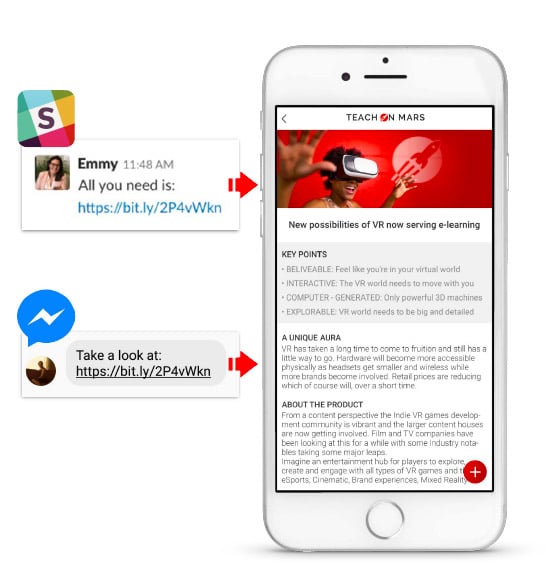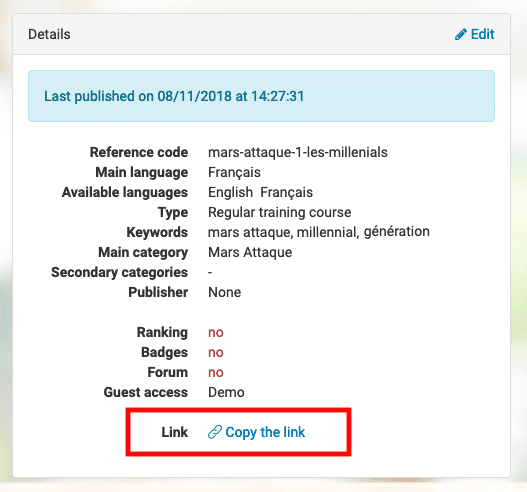The Mission Center now allows you to generate a direct link to your learning content, whether in the form of training courses, activities or communications on the Wall. Here are nine relevant ways of using link sharing to boost your training offer.


If required, a direct link can automatically enrol a learner on a chosen training programme if they don’t already have access to it. With a bit of technology, you can even create a direct link to a given activity within a training course!
1. Promote content in your digital ecosystem
As we mentioned in a previous post entitled “Five techniques to leverage the visibility of your mobile learning programmes”, sharing a link via copy/paste is one of the most natural ways of forwarding content.
Maybe you have a new training course or article that you’d like to publicise? Send a direct link to your learners in a newsletter, email or via a corporate social network. They will then be taken directly to your content. And if they haven’t yet downloaded the app, the link will direct them to the download page on the stores.
NB: To share multiple training courses at the same time, insert the links to the different trainings in an article, and then share the link for that article. This can be useful if you want to announce a new product line and offer training courses specific to each product.
2. Prepare your learners for a face-to-face session
Because mobile learning is a good way of preparing learners for a face-to-face training session, we recommend reminding any audience with an upcoming session that a mobile course is available to them.
You can automatically program a series of emails with a tool such as Mailchimp, and its automation feature (details) allows you to send regular reminders to your learners over the two weeks prior to your session, until they click on the link!
3. Embrace pervasive learning
Integrating a training course into everyday tools takes you a step closer to pervasive learning. By automating processes with a tool such as Zapier, you can, for example, send a message in Slack to any new employee in your organisation and thus offer them a series of onboarding training sessions.
You can also offer training courses to anyone who registers directly via the online form of your choice (Google Forms, etc.), again using Zapier.
As you can see, there are many avenues to explore!
4. Incorporate an article into a training course
Connoisseurs of the Teach on Mars solution use articles, a form of content that can be published on the Wall at any time. If an article has created a buzz and the likes and shares counter has exceeded your expectations, it would be a shame for it to get lost in the limbo of the news feed. A direct link can help you avoid such a situation!
Create a “web link” activity in a training course and include the direct link to your article. And hey presto – your content can now be accessed from your training catalogue until you decide to remove it. (Note that your article will still be accessible via the Search function).
5. Experiment with “phygital” strategies
The term “phygital” was first coined in 2013 to describe the use of innovative technologies in physical points of sale to improve customer experience. In the context of current training programmes, we could compare it to the blended learning created by digital and face-to-face sessions.
Using direct links, experiment with “phygital” strategies in a point of sale by displaying, for example, a QR code offering content linked to a selection of products. You can choose whether you limit access to the sales force, or allow visitors to download the app to their mobile phones so that they can discover the many benefits of your products.
6. Create a multi-level training course
Here’s something to delight many of the trainers out there! Direct links can be used to easily create training courses featuring several levels (in terms of difficulty or development).
It was already possible to create modules in training programmes that could only be accessed once the previous module had been completed. Now this concept can be extended to several different training courses by adding a “web link” activity to the last module which contains a link to the next level of training.
In this way, only learners who have completed all modules of one course can access the next one.
7. Make a success of employee onboarding
Consider the previous idea (6. Create a multi-level training course), and take it further: by playing with the different features offered by the Teach on Mars solution, you can devise a real-life treasure hunt to create a fun and unique onboarding programme.
Start by giving new employees a simple QR code to scan. This will take them to your app where a first set of content will give them an overview of your company’s history. At the end of this content, the new employee will be invited to use the Search function of the app to find a given article containing a hidden direct link to a second training component (for example on your product line), and so on.
You can also help employees learn about the company’s premises or departments by asking them to make physical visits (before continuing their quest via a new QR code or beacon), etc.
This is a fantastic and engaging way of welcoming new members of staff to your company.
8. Promote your training courses outside your digital ecosystem
Being old school isn’t always a bad thing. An attractive poster on your premises can encourage employees to explore content on your mobile app. Using simple QR codes, you can suggest relevant content and accelerate deployment of your learning offer while also upskilling your teams.
9. Use the surprise factor
Doing something out of the ordinary from time to time can be stimulating. Why not send a quirky push notification to all your learners offering them a completely innovative activity they won’t have seen in any other training course?
Surprise them with a classic game (how about Tetris via a web activity?), offering a prize to the 10 fastest or highest scoring players. This will create a buzz around your mobile learning app, and significantly increase your user numbers!
The ball’s now in your court!
We hope this post has given you lots of ideas on how to use this new feature, through which you can develop the skills and engagement of your audience. If you have other ideas to share, please leave them in the comments below.

Delphine accompagne depuis plus de 20 les organisations dans leurs grands projets de transformation. Après une première expérience de 7 ans dans le conseil sur des dispositifs d’accompagnement au changement (mise en place de nouveaux modèles d’organisation, accompagnement des collaborateurs dans le cadre de fusions, évolution de pratiques managériales/RH…), elle a intégré le groupe Crossknowledge en 2005 et déployé une offre de services novatrice pour assurer le succès des projets de digital learning dans les grands groupes. Elle a rejoint ensuite Teach on Mars en 2018, et en est le COO depuis 2021. Elle pilote actuellement le développement du portefeuille de clients existants ainsi que les activités de notoriété de la marque.




